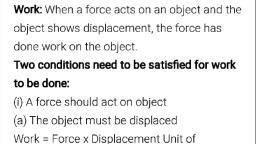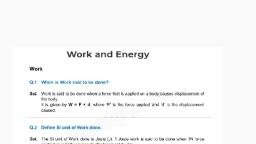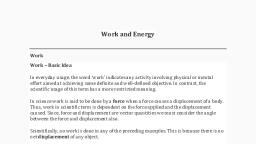Page 1 :
VIJAYA SCHOOL, HASSAN., Class : 9, , WORK AND ENERGY, , 1. Define work. How is work done measured when a body moves in the direction, of the applied force ?, Work is said to be done when the point of application of a force moves., The magnitude of work done by a force acting on a body is equal to the product, of force exerted on the body and the distance moved by the body in the direction of, force., Work done = Force X Displacement Note :, • When force makes angle θ with displacement s of the body,, W = Fscosθ., For maximum work, θ = 0o., For minimum work, θ = 90o(Thus, work done by a force is minimum or zero, when the displacement of the body is perpendicular to the direction of force)., 2. When is the work done by a force is said to be (a) positive and (b) negative ? Give, examples., (a), Positive work : Work done by a force is positive if the force acts in the, direction of displacement., Then, W = F X s X cos0o = F X s X 1 = F s Ex :, • When a horse pulls a cart, the work done by the horse is negative., • When a body falls freely under gravity, the work done by the force of gravity is, positive., (b) Negative work : Work done by a force is negative if the force acts opposite to the, direction of displacement., Then, W = F X s X cos180o = F X s X (-1) = - F s. Ex :, • When brakes are applied to a moving vehicle, the work done by the braking force, is negative., • When a body is lifted vertically up, the work done by the gravitational force is, negative., 3. Name and define the SI unit of work., The SI unit of work is joule(J)., One joule of work is said to be done when a force of one newton displaces a body, through a distance of one metre in its own path., 1 joule = 1 newton X 1 metre, or, 1 J = 1 Nm.
Page 2 :
4. Is work done a scalar or vector quantity ?, Work done is a scalar quantity because it has only magnitude and no direction., 5. Define energy., Energy of a body is defined as its capacity to do work., 6. How does the energy of an object change when it performs work or work is done on it ?, When an object performs work, it loses energy. When work is done on an, object, the object gains energy., 7. Name the different forms of energy., Mechanical energy, sound energy, heat energy, light energy, chemical energy, nuclear, energy, electrical energy, magnetic energy, solar energy etc are the different forms of, energy., 8. Is energy a scalar or vector quantity ?, Energy is a scalar quantity because it has only magnitude and no direction., 9. What are the two forms of mechanical energy ?, Kinetic energy and potential energy are the two forms of mechanical energy., 10., What is kinetic energy ? Give examples., The energy possessed by a body by virtue of its motion is called its kinetic energy., Ex : flowing water, bullet fired from a gun, blowing wind etc., 11., Derive an expression for the kinetic energy of an object of an object of, mass ‘m’ moving with a uniform velocity v., The kinetic energy of a body can be determined by calculating the amount of work, required to set the body into motion with the velocity v from its state of rest as shown in, the figure., At rest, F, , m, , m, , v, , s, , Let, , As, , m = mass of the body,, u =initial velocity of the body = 0, F =, force applied on the body,, a = acceleration produced in the body in the direction of force, v = final, velocity of the body,, s = distance travelled by the body., v2 – u2 = 2as, s = v2 – u2/ 2a, s = v2/2a, ( because u = 0)
Page 3 :
As the force and displacement are in the same direction, the work done on the body is, W=Fs, W = (ma)(v2/2a) W, = ½ mv2, This work done is equal to the kinetic energy of the body., Thus, the kinetic energy possessed by an object of mass, m and moving with a uniform, velocity, v is, Ek = ½ mv2., 12. State the factors on which the kinetic energy of a moving body depends., a) Kinetic energy of a body is directly proportional to its mass., b) Kinetic energy of a body is directly proportional to the square of its velocity., 13., What is potential energy ? Give examples., The energy possessed by a body by virtue of its position or deformation is called its potential, energy., Ex : water stored in a dam, stretched rubber band etc., 14., Define acceleration due to gravity., Acceleration gained by a body due to gravitational force is called acceleration, due to gravity., It is denoted by ‘g’. Its value is approximately equal to 9.8 ms-2., 15. What is gravitational potential energy. Deduce an expression for the gravitational, potential energy of a body of mass m placed at a height h above the ground., The gravitational potential energy of an object at a point above the ground, is defined as the work done in raising it from the ground to that point against gravity., Expression for the gravitational potential energy :, Consider an object of mass, m. Let it be raised through a height, h from the ground. A, force is required to do this. The minimum force required to raise the object is equal to the, weight of the object, mg. The object gains energy equal to the work done on it. Let the, work done on the object against gravity be W., That is,, W = force X displacement, = mg X h, = mgh, The work done on the object is equal to the energy gained by the object. Thus, the potential, energy ie.,Ep = mgh.
Page 4 :
Note : The gravitational potential energy of a body does not depend on the path along which, the body is moved., 16., , What are the factors on which potential energy depends ?, Potential energy of a body depends upon, a) the mass of a body and, b) the height to which it is raised from the ground., 17., State the law of conservation of energy., The law of conservation of energy states that energy can neither be created nor be, destroyed. It can only be converted from one form to another., 18., Describe the relationship between work and energy., Whenever work is done, the object that does work loses energy and the object on which, work is done, gains energy., 19., Define power., Power is defined as the rate of doing work or the rate of transfer of energy.., If an agent does work W in time t, then its power is given by, 𝑊𝑜𝑟𝑘 𝑑𝑜𝑛𝑒, or, P=𝑊, Power =, 𝑡𝑖𝑚𝑒 𝑡𝑎𝑘𝑒𝑛, , 20., , 𝑡, , Name and define the SI unit of power., The SI unit of power is watt (W)., The power of a body is one watt, if one joule of work is done in one second., 1 W = 1J, 1𝑠, , Note : 1 kilo watt = 1000 W., 21., , Name the commercial unit of energy., The commercial unit of electric energy is kilowatt-hour (kWh)., 22., Define one kWh. Express it in joules., One kWh is the electric energy used in one hour at the rate of 1 kW., 1 kW h = 1 kW X 1 h, = 1000 W X 3600 s, = 3600000 J, 1 kW h = 3.6 X 106 J.





















































































